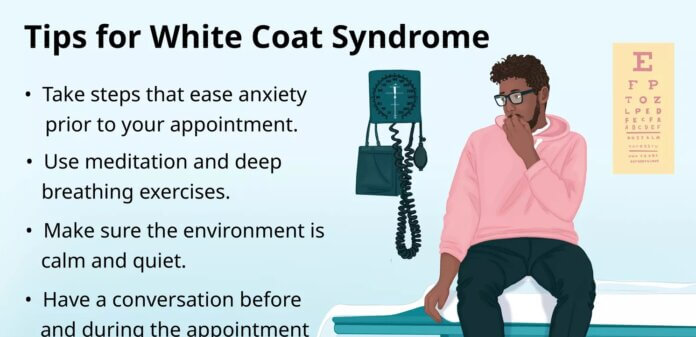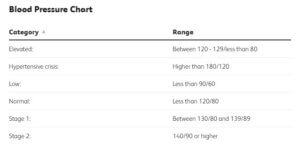What Is White Coat Syndrome?
White coat syndrome refers to a temporary spike in blood pressure when a person visits a healthcare provider. This happens due to anxiety or stress triggered by the clinical environment, often leading to a false diagnosis of high blood pressure (hypertension). While some individuals’ blood pressure returns to normal after repeated visits, others consistently experience this effect.
Why Does Blood Pressure Spike in a Clinical Setting?
Blood pressure is the force of blood pushing against the walls of arteries. It consists of two measurements:
- Systolic pressure (top number): Pressure when the heart beats.
- Diastolic pressure (bottom number): Pressure when the heart rests between beats.
White coat syndrome occurs because of stress responses in the body. The fear or nervousness of a doctor’s visit can activate the “fight-or-flight” reaction, releasing adrenaline and temporarily increasing blood pressure.
How Is White Coat Syndrome Diagnosed?
Doctors diagnose white coat syndrome by comparing in-office blood pressure readings with at-home readings. If blood pressure is consistently normal at home but elevated in a clinic, it indicates white coat syndrome. Some patients may undergo ambulatory blood pressure monitoring, where a device records blood pressure over 24 hours to track patterns accurately.
Blood Pressure Categories
A standard blood pressure chart helps determine normal and high readings:
- Normal: Less than 120/80 mmHg
- Elevated: 120-129/<80 mmHg
- Stage 1 Hypertension: 130-139/80-89 mmHg
- Stage 2 Hypertension: 140/90 mmHg or higher
- Hypertensive Crisis: Higher than 180/120 mmHg (requires emergency care)
Read More: Satisfying Acne Removal: The Ordinary’s 3-Step Regimen for Clear, Radiant Skin
Risks Associated with White Coat Syndrome
Though temporary, white coat syndrome isn’t entirely harmless. Studies show that people with white coat syndrome have a 2.5 times higher risk of developing chronic hypertension. It is also linked to:
- Arterial stiffness: Reduced ability of arteries to expand and contract.
- Increased cardiovascular risks: Higher chances of heart disease and stroke than those with normal blood pressure.
- Misdiagnosis and overmedication: Doctors may mistakenly prescribe medications for non-existent hypertension.
The Opposite Condition: Masked Hypertension
Some people experience masked hypertension, where their blood pressure appears normal in a clinical setting but is high at home. This condition is dangerous because it can lead to undiagnosed and untreated high blood pressure, increasing the risk of heart disease and organ damage.
Who Is at Risk for White Coat Syndrome?
White coat syndrome is common among:
- Older adults (especially those over 50)
- Women
- People with anxiety disorders
- Individuals with past traumatic medical experiences
How to Manage White Coat Syndrome
Since white coat syndrome is stress-related, lifestyle changes and relaxation techniques can help manage it.
At Home:
- Monitor Blood Pressure: Use a home blood pressure monitor to track your readings in a calm environment.
- Practice Relaxation: Engage in activities like yoga, meditation, and deep breathing exercises.
- Reduce Caffeine and Alcohol: Both can cause temporary spikes in blood pressure.
- Exercise Regularly: Aim for at least 150 minutes of moderate exercise per week.
At a Doctor’s Office:
- Arrive Early: Avoid rushing to your appointment, as stress can elevate blood pressure.
- Practice Deep Breathing: Take slow, deep breaths before and during the reading.
- Request Multiple Readings: Ask your doctor to take multiple readings after a few minutes of rest.
- Bring a Companion: Having a friend or family member with you can reduce anxiety.
- Distract Yourself: Listen to calming music or engage in conversation to shift focus away from the test.
Read More: Best Collagen Protein Powder? Ancient Nutrition Collagen Review (Vanilla Flavor)
Managing Chronic High Blood Pressure
If you have true hypertension, lifestyle changes and medications may be necessary. Lifestyle adjustments include:
- Reducing salt intake
- Eating a heart-healthy diet (such as the DASH diet)
- Getting quality sleep
- Managing stress effectively
- Quitting smoking
If lifestyle changes are not enough, doctors may prescribe medications like:
- ACE inhibitors (e.g., benazepril, enalapril)
- ARB blockers (e.g., azilsartan, candesartan)
- Calcium channel blockers (e.g., amlodipine, verapamil)
- Diuretics (e.g., bumetanide, spironolactone)
Conclusion
White coat syndrome can lead to misleading blood pressure readings, potentially resulting in unnecessary treatments or missed diagnoses. Understanding this condition and using relaxation techniques can help manage its effects. If high blood pressure is confirmed, lifestyle changes and proper medication management can ensure long-term heart health.













